I’ve always loved cakes, and the excitement of a birthday or special day was always about the cake. Seeing those layers, frosting, and toppings made me so eager. Now, I want to teach you how to draw cakes that look as good as they taste.
If you’re new to drawing or want to make something fun with your kids, this guide is for you. You’ll learn how to draw cakes step by step. It’s all about the fun of creating something delicious-looking on paper. So, let’s get started and make your own pastry art!
Introduction to Drawing Delectable Cake Art
Start a fun journey into the world of cake drawing. You’ll learn to draw a delicious cake with simple steps. This guide is for everyone, whether you’re new or want to improve your skills.
Drawing cakes is both fun and useful for learning art. It helps you understand perspective, proportion, texture, and color. You’ll also get a unique cake-themed artwork to show off or give away.
We’ll show you how to pick the right supplies and add the final touches. By the end, you’ll be ready to create your own tasty-looking cake drawings. Let’s explore the world of cake drawing, easy food art, and simple cake illustration for cake sketching beginners.
Gathering Essential Art Supplies
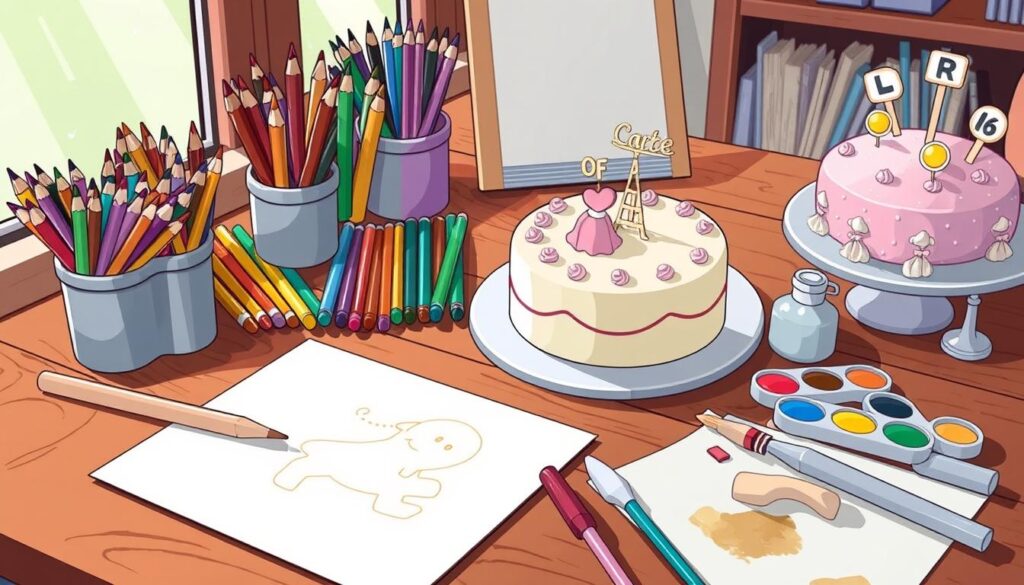
Before starting your cake drawing journey, make sure you have the right supplies. Whether you’re new or experienced, the right tools make the process fun and easy. You’ll need everything from graphite pencils to watercolor paints to create stunning cake illustrations.
A good graphite pencil is key. Choose one that offers different lead softness for detailed work and shading. For your cake’s underpainting, watercolor paints are essential. Make sure you have various brush sizes for both big washes and small details.
| Art Supply | Recommended Brand | Benefits |
|---|---|---|
| Graphite Pencils | Biggie Brand | Durable, versatile for sketching and shading |
| Watercolor Paint | Crayola Washable Paint | Vibrant colors, affordable for beginners |
| Paintbrushes | Royal Langnickel | High-quality bristles for smooth application |
| Colored Pencils | Cray-Pas Oil Pastels | Blendable, create rich textures |
| Drawing Paper | Tru-Ray Construction Paper | Sturdy, fade-resistant for long-lasting art |
Colored pencils are vital for adding depth to your cake drawings. Choose ones that blend well, like Cray-Pas oil pastels. Also, get good drawing paper, like Tru-Ray, to keep your art looking great.
With these essential supplies, you’re ready to create amazing cake designs. Whether you’re just starting or looking to improve, having the right tools makes the journey fun and rewarding.
Conceptualizing Your Cake Drawing Design
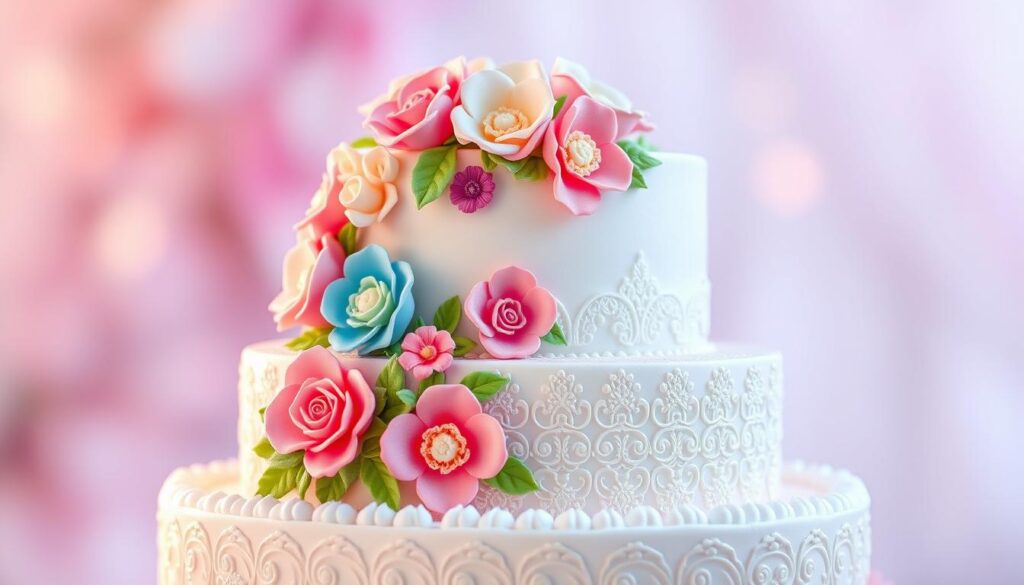
Starting an alluring cake drawing begins with a design concept. As a budding cake artist, this phase lets you shape your vision. Think about the cake’s shape, layers, and decorations. Drawing from your favorite desserts can make your cake illustration both unique and appetizing.
To kick things off, look at cake drawing design ideas that reflect your style. Today’s top cake trends include wafer paper and metallic touches, which add a wow factor. Learning from cake masters like Kara’s Couture Cakes can spark your creativity.
| Cake Design Trend | Popularity |
|---|---|
| Wafer Paper and Metallics | Most Popular |
| Unique and Creative Cakes | Kara’s Norm |
When planning your cake art, think about its shape, layers, and details. Sketching your ideas can help you see the final look. This way, you can plan the finer points before starting to draw. With a clear idea, you’re set to draw your delicious cake illustration.
Sketching the Cake With a Graphite Pencil
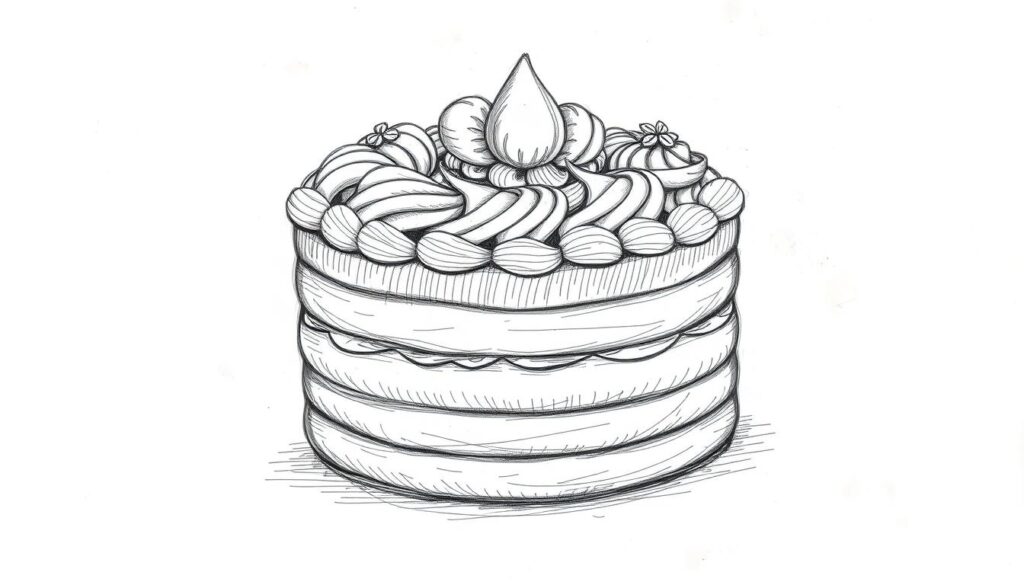
When you have a clear idea, start sketching the cake with a graphite pencil. This step sets up the cake’s structure, like layers and decorations. You’ll also learn to add depth and texture to your drawing.
Begin by lightly drawing the cake’s shape, focusing on its tiers. Make sure the parts fit well together. Then, add decorations like a tangerine slice and nuts. Use your pencil to show different textures, making the cake look real.
Playing with perspective is key to a great cake drawing. Try drawing it from different angles, like a three-quarter view. This adds depth and interest. Don’t forget to add shadows and highlights to make it look even more appealing.
Take your time with this step. It’s important for the rest of your drawing. Try different pencil techniques to get a detailed, realistic look. Your goal is to capture the beauty of your cake design.
Establishing an Underpainting With Watercolors
After you finish the pencil sketch, it’s time to start the underpainting with watercolors. This step is key to setting up a color and value base. It saves time before you start with colored pencils. By learning how to apply watercolor paint, you can make smooth transitions and add splashes for a richer look to your cake drawing with watercolor.
Think about the watercolor set you’re using. Student-grade paints might need more use than artist-grade. Some sets have up to 50 colors, giving you lots of options. Try out different sets to find what works best for you.
When painting with watercolors, build up layers and aim for soft blends. Don’t overwork the paint to avoid a muddy look. Let the paint move freely on the paper, creating a stunning underpainting for your cake.
Feel free to try new things, like adding splashes or textures with tools. Watercolor’s spontaneity can add a lot of personality to your cake drawing. It prepares the stage for the next steps in your project.
Developing Texture With Colored Pencils
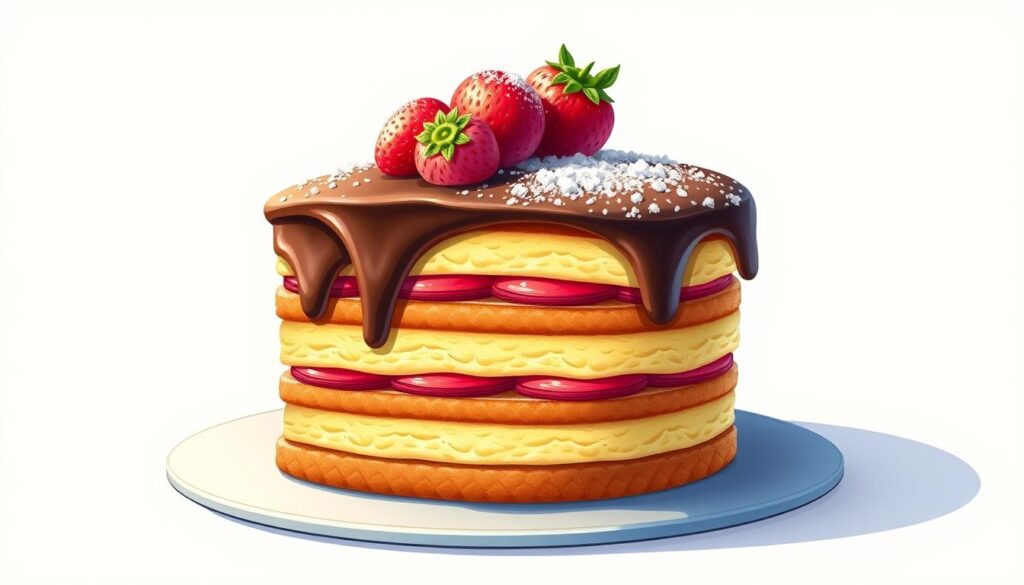
Get ready to add captivating texture to your cake drawing using colored pencils. This guide will show you how to layer and blend pencils. You’ll learn to create the cake’s biscuit layers, creamy fillings, and rich chocolate frosting.
Begin with warm colors like vibrant yellow and bright red for the cake’s texture. Then, use various shades of brown to show the cake’s different parts. A key technique is to leave clear, precise hatches and soft, rubbing strokes for a realistic look.
Adjust your method based on the texture you want, like creamy or smooth. The tutorial will walk you through drawing the cake and its details. Blending colors and adding delicate nuances is key for a polished look.
Vary the direction and character of your strokes to enhance texture. Use colors like light rosy, raspberry red, and dark brown to add depth. Refine shades, add color accents, and increase contrast for a captivating cake drawing.
For the best results, use high-quality Prismacolor Premier colored pencils. Pair them with Stonehenge paper for a textured surface. Use a colorless blender pencil to blend colors for a seamless look.
As you work on your cake drawing, layer colors with light pressure. Mix and match hues to create unique shades. With practice, you’ll master adding irresistible texture to your cake illustrations.
Easy Cake Drawing Techniques for Beginners
Unleash your inner artist and learn to create simple yet delightful cake drawings. These beginner-friendly techniques are perfect for anyone looking to add creativity to their life. Mastering cake illustration can be a rewarding experience.
Start by learning the basic shapes of a cake. These include the rounded top, straight sides, and decorative elements like frosting and sprinkles. Breaking down the cake into these simple shapes makes it easy to draw, even if you’re new to drawing.
Use basic art supplies like pencils, colored pencils, and watercolors to bring your cake drawing to life. Experiment with layering different media to add texture and depth. Don’t be afraid to add your own flair with swirls, patterns, or whimsical toppings.
The key to easy cake drawings is to focus on the essential elements and have fun. With practice and imagination, you’ll create cake illustrations that impress everyone.
Dive into the world of simple cake drawing for beginners, easy cake illustration steps, and cake art tutorials for kids. Unlock your artistic talent and unleash your inner pastry artist.
Adding Tempting Details and Highlights
It’s time to add the final touches to your cake drawing. Making it mouthwatering is all about the details. Use highlights and shadows to make it look real and three-dimensional.
Don’t use straight black for shadows. Instead, mix a bit of black or a cool color with the cake’s original color. A mix of ultramarine blue and burnt umber creates a deep, rich black for shading.
To add shadows, paint directly on the cake and blend the edges. Or, use a glaze made from paint and medium for a gradual darkening. Shadows aren’t always dark. Even light cakes can have subtle shading.
Highlights add depth to your cake drawing. Paint them at the cake’s highest points, near the light source. Mix white with the base color, blending carefully. Use pure white highlights sparingly to avoid a stark look.
Try mixing colors for highlights, like transparent white or warm complements. This creates natural and appealing effects. Think about the light source and how it affects the cake to place highlights and shadows right.
Mastering these techniques takes time, but it’s worth it. Your cake drawing will look alive with depth and texture. It will be so appealing that it will make everyone want to take a bite.
Finishing Touches for a Polished Cake Drawing

As you near the end of your cake drawing journey, it’s time to add the final touches. These steps are key to polishing your artwork and making it look professional.
First, examine the edges of your cake drawing. Use a blending stump or your fingers to soften any hard lines. This makes your cake art look more natural and seamless.
Next, check the contrast in your illustration. Are the highlights and shadows right? Use colored pencils to adjust the contrast, blending edges carefully for a harmonious look.
Lastly, review your cake drawing and make any final tweaks. This might include refining details or textures. By doing this, you’ll complete your cake illustration and show off your artistic skills with a polished cake art piece.
Remember, a successful cake drawing takes time and patience. With these finishing touches, your cake illustration will not only look tasty but also showcase your unique style.
Displaying and Gifting Your Cake Artwork
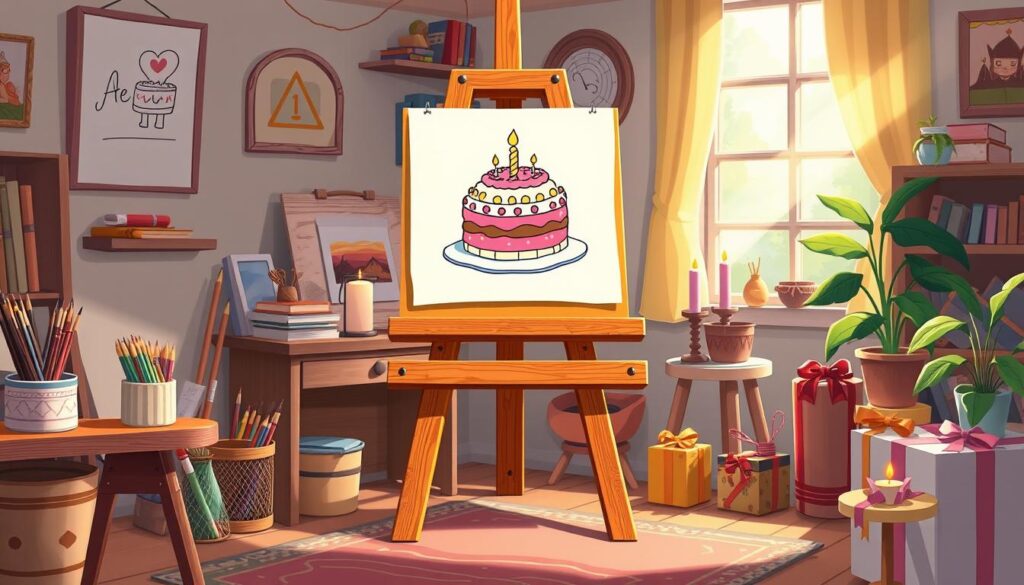
Now that you’ve mastered the art of creating a delightful cake drawing, it’s time to showcase your masterpiece. Whether you plan to frame your cake illustration for personal enjoyment or transform it into a thoughtful gift, this section offers practical tips to help you display and share your cake art with the world.
One of the easiest ways to display your cake drawing is by framing it. Choose a frame that complements the style and colors of your artwork, and consider adding a mat to make the drawing stand out. You could also create greeting cards or gift tags featuring your cake illustration, perfect for sharing your creativity with family and friends.
If you’re looking to gift your cake art, consider incorporating it into a baked treat or using it as the centerpiece of a handmade gift basket. You could also transform your drawing into a set of coasters or a decorative plate, making it a functional and visually appealing gift.
Regardless of how you choose to showcase your cake artwork, the key is to find unique and personalized ways to share your talent and creativity. By thoughtfully displaying or gifting your cake drawing, you’ll not only bring joy to others but also celebrate your own artistic achievements.
| Cake Height | Buttercream Filling | Modeling Chocolate Thickness | Polka Dot Circles |
|---|---|---|---|
| 5″ | 5 oz | 1/16″ to 1/8″ | 180+ pink, 130+ blue |
Tips for Continued Cake Drawing Practice
Drawing delicious cakes is a skill that gets better with practice. I’ll share tips to help you improve your cake drawing skills. Remember, creativity and persistence are key to mastering easy cake drawing.
Try drawing different types of cakes to boost your skills. You could draw classic birthday cakes, festive holiday treats, or even creative cakes like snail-shaped, bunny, and lavender ones. Drawing various cakes will make you more versatile.
Don’t be afraid to try different art materials. This tutorial used graphite pencils, watercolors, and colored pencils. But markers or acrylics might give your cakes unique textures and effects. Mixing media can lead to amazing results.
